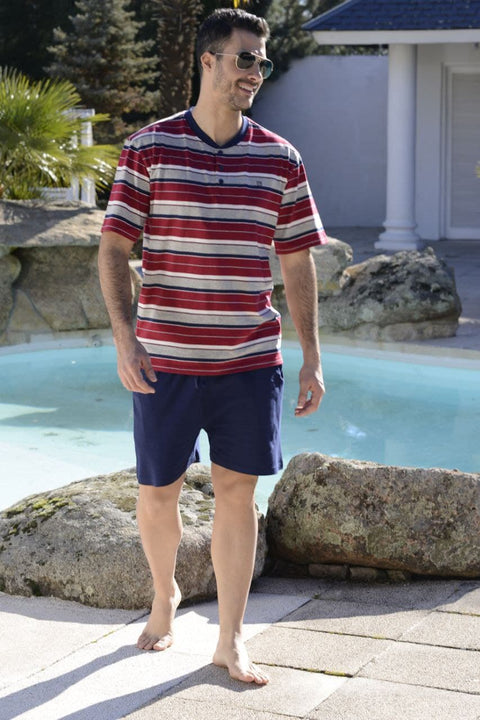Choosing the pajama right for better sleep at night is sometimes not so easy. Sleeping well requires more than setting a consistent bedtime. In fact, creating the right sleep environment, considering light, temperature, and more, can make the difference between restless sleep and a long, full night of rest.
Without a doubt, the important element is to choose the right pajama for sleeping; choosing a pajama to help maintain good sleep is surprisingly simple.
Focus On The Woven
First of all, you have to choose sleepwear that feels good when worn. If the slippery feeling of silk is not pleasant, for example, you will not be able to sleep well in silky pajamas. Being strategic about what sleepwear is made of can also help regulate body temperature properly throughout the night, which in turn can promote better sleep. So it is recommended to consider the following wovens:
As Always Cotton
This completely natural fabric is light and soft to the touch; it is also breathable, allowing air circulation and does not tend to irritate the skin. However, cotton does not do a good job of insulation and can cause cold if used in cooler weather without the proper blankets. It is also inefficient at wicking moisture, so if night sweats are experienced, it may not be the best choice.
Good Silk
This woven is a magical thermoregulator: it can keep the body warm when cold and cool when hot. That said, real silk is expensive and requires dry cleaning. It is also slippery and can move while you sleep.
Simple Flannel
For the colder months, a pajama made with this woven soft woven can be just what you need. The material is comfortable and provides warmth and breathability, so it can be very helpful to stay warm without overheating.
Absorbs moisture: if getting hot while sleeping is a daily occurrence, or if night sweats are often experienced, moisture-absorbing sleepwear may be the best option. These materials are designed to pull water away from the skin, helping the body self-regulate temperature.
Bamboo
This woven, made from fibers of the abundant plant, feels soft and silky on the skin. It is a natural moisture wicker, so it stays at a pleasant temperature. Additionally, it is hypoallergenic and may have antibacterial properties that are beneficial for allergic people. Last but not least, it is 100% biodegradable, a great advantage if one has ecological tendencies.
Wool and Fleece for Warmth
While these fabrics provide abundant warmth, they can actually promote overheating. Additionally, wool can irritate the skin and cause itching that wakes you during the night. And fleece does not allow air circulation, so it may encourage sweating.
Attention to Details
When buying sleepwear, one must think about more than just the woven. The fit is important, as looser pajamas move more easily over the body when sleeping, rather than squeezing or tying. Elements like buttons, snaps, and tags can become problematic because they itch or irritate during the night. Also, make sure no elastic is too tight to cut circulation or too loose to slip off while sleeping.
Don’t Forget the Feet
A component often forgotten when choosing what to wear to sleep is what to do with the lower limbs. Cold feet are actually associated with insomnia. But overheating the feet can make the whole body too hot. If one tends to feel cold while sleeping, it is advisable to wear a pair of light socks at bedtime.
Ultimately, personal comfort is supreme when choosing the right sleepwear, whether it is a silk shirt, classic cotton pajamas, an elastic jersey nightshirt, or nothing at all.
Pajamas and the Mind
Could wearing pajamas all day psychologically affect you? Whether it is a conscious choice because it is more comfortable, or you blink and suddenly it is already noon. But could the choice of clothing prevent fulfilling all responsibilities and pending tasks? What many might consider insignificant can lead to a decrease in motivation and productivity as pajamas are unconsciously associated with bedtime or relaxation time. Therefore, by wearing relaxed clothing, the brain could also start to feel inactive. Furthermore, if working from home, maintaining that separation between work life and home life is very important.
Just as it is ideal to have a designated workspace, it is also important not to let work invade your entire home life. Putting on and taking off clothes for the workday can help establish a psychological marker between private time and work time.
It Can Affect Self-Esteem
According to research conducted by the University of Hertfordshire in England, people admitted to equating clothing with attitude, specifically saying that if you are in casual clothes, you get a high degree of relaxation, but if you are wearing smart clothes for a meeting or special occasion, it can alter the way you walk and even how you hold yourself. Unconsciously, you are sending a message to your mind and body that you intend to be productive and attend to needs, which in turn can directly affect self-esteem.
Work and Empathy
Another study found that wearing a nicer outfit could change the feelings you have about work. For example, some people feel more empowered, trustworthy, and competent when wearing formal business attire, but friendlier when wearing casual or business casual clothes.
So, if you have recently felt that you have been overly relaxed at work, you might want to change the pajama pants you are wearing for something a bit more office-friendly for the hours we work from home and remotely.
Sleep Impairment
The next time you are tossing and turning in bed at 2 a.m., unable to fall asleep, think about the clothes you were wearing the day before. Wearing pajamas all day and not sticking to usual work schedules could cause a disruption in the internal biological clock and lead to sleep problems, along with low energy and bad mood.
All these symptoms can lead to mental health problems in the future. Additionally, it should be added that since humans thrive on routines, incorporating structure into the day (even if that only means changing clothes every morning) could help reduce anxiety and help you feel confident again.
For all these reasons, we invite you to get to know us. Visit the website of El Búho Nocturno where you will find the ideal pajamas for you. We are sure!

